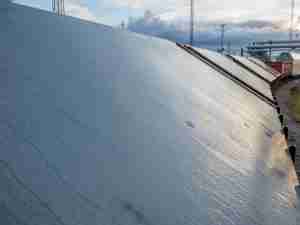Japan’s industrial production dropped the most since the March 2011 earthquake as falling exports sapped demand and a steel-mill explosion halted domestic car production at Toyota Motor Corp.
Output slumped 6.2 percent in February after rising in January, the trade ministry said on Wednesday. Economists surveyed by Bloomberg had forecast a 5.9 percent drop. The government projects output will expand 3.9 percent this month.
The ministry estimates that production for the three months ending Thursday may shrink. This casts a shadow over gross domestic product for the whole quarter, underscoring Japan’s struggle to bounce back from a contraction at the end of last year. Shipments of capital goods also slumped last month, indicating sluggish business investment.
“The slump in industrial output in February suggests that manufacturing activity will contract this quarter,” Marcel Thieliant, senior Japan economist at Capital Economics, wrote in a note. This means there is a growing risk that the economy won’t expand this quarter after the contraction in the final three months of last year, Thieliant wrote.
With pressure building on policy makers to bolster growth, Prime Minister Shinzo Abe said Tuesday that the government would front load spending after parliament passed a record budget for the 12 months starting April 1. He resisted calls for a supplementary fiscal package.
The government will probably compile new economic measures before the Group of Seven Summit in May, said Norio Miyagawa, an economist at Mizuho Securities in Tokyo.
Even taking out the fall in production at Toyota and the lunar new year, production for February was poor, according to Hiroaki Muto, chief economist at Tokai Tokyo Research Center.
“The outlook for production looks weak as demand in emerging nations, as well as industrialized nations including the U.S., is slowing,” Muto said. “Japan’s economy may avoid falling into a recession, but any rebound in the first quarter will be weak.”
The yen strengthened after the data, trading at 112.49 per dollar at 12:59 p.m. in Tokyo. The currency rose after Federal Reserve Chair Janet Yellen stressed that interest rates in the U.S. will be raised at a cautious pace. The Topix index of stocks was down 0.9 percent.
GDP Forecasts
The median from economists surveyed by Bloomberg is for 0.6 percent growth in the January-March period. If gross domestic product shrinks again, that would be the sixth quarterly contraction and second recession since Abe returned as prime minister in December 2012.
Abe came to power promising to reform the nation and drag the economy out of a deflationary malaise. Since then, inflation rose, and then fell back to about 0 percent, and the real economy has grown a total of 2.1 percent.
Toyota’s domestic production of cars and light trucks fell 19 percent in February from a year ago. The company suspended production at assembly plants in Japan after an explosion at Aichi Steel Corp.’s Chita plant, which supplies specialty steel for engine, transmission and chassis components.
The trade ministry’s report also shows:
- The transport sector was the biggest contributor to the drop. Motor vehicles make up about 16 percent of the index.
- Shipments from factories dropped 4.6 percent from January, which was also the biggest fall since March 2011.
- Shipments of capital goods excluding transport equipment, an indicator of business investment, fell more than 10 percent in February from the previous month. That’s the biggest drop in a year
- Production is forecast to fall 0.7 percent in the first quarter from the previous three months, if applying the ministry’s March forecast figure






